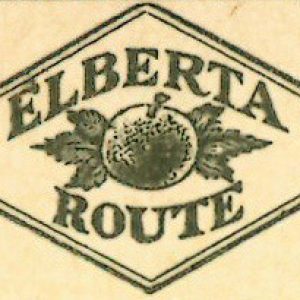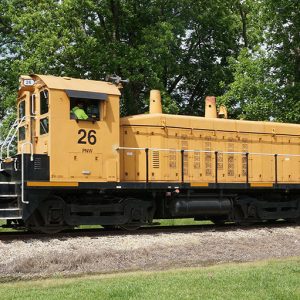calsfoundation@cals.org
Prescott and Northwestern Railroad
The Prescott and Northwestern Railroad (P&NW), a southwestern Arkansas short-line railroad, was established in the late 1800s to serve timber operations. It continues in the twenty-first century, although in a much abbreviated form, to convey freight cars to and from the Union Pacific main line that passes through Prescott (Nevada County).
P&NW Beginning
Prescott developed astride a railroad connecting Missouri and Texas. Completed in 1874, it was absorbed by the St. Louis, Iron Mountain and Southern (SLIM&S), which in turn would be merged into the Missouri Pacific (MP) in 1917. The combination of newly available transportation and vast stands of timber soon drew attention to the region. In 1890, two owners of a Texas sawmill, J. H. Bemis and Benjamin Whitaker, ventured into the area and struck a deal to locate a sawmill in Prescott and obtain timber from Dr. R. L. Powers.
As there were limitations to what could be hauled by wagons on dirt roads, to transport logs to the mill, Powers incorporated Prescott and Northwestern on October 16, 1890. In the first quarter of 1891, a P&NW representative brought a steam engine back from New York. The rails were laid and the sawmill machinery assembled. The mill and railroad both got off to a rousing start, with sixty cars sent on to SLIM&S in May, and rails were laid beyond Arcadia (Hempstead County). But by late summer, shifting economic circumstances had led to financial troubles, which sent the railroad and the mill (by this time referred to as Ozan Lumber) into court. Both would shut down, to resume operation in February 1892.
There was management turnover and a reorganization in 1892, with the name becoming the Prescott and Northwestern Railroad Company. The Bemis family would gain control, and in May 1894, the railroad was mortgaged to Ozan.
During the early years, the small railroad slowly extended track as needed to reach fresh stands of timber. It was listed as a “logging road” with one locomotive, a few freight cars, and a caboose.
P&NW in Its Heyday
Sources from around 1900 present conflicting pictures about the development of the railroad. Aggregate evidence suggests that the line in 1900 extended around twenty-four miles, ending west of present-day McCaskill (Hempstead County). Regardless, the route map varied frequently, as branches were removed once the timber in that area had been cut and new branches were laid into new timber. The tracks reached Tokio (Hempstead County) in 1903.
As the railroad’s length expanded, so did its fleet. By the early 1900s, it had grown to include four locomotives and two passenger cars. P&NW purchased a Shay locomotive from Lima in 1903. A mid-1906 report showed the railroad ordering twenty new flatcars plus a combination baggage-passenger car. In 1907, it again placed a locomotive order with Lima, this time for a 4-6-0.
Documents of the time displayed an intent to build northward to Daisy (Pike County). A 1906 timetable had passenger service extending forty miles from Prescott to Helbig (Pike County), named for the P&NW secretary, treasurer, and traffic manager. Schedules from 1907 showed that P&NW was still ten miles shy of Daisy, but there were three branches, plus P&NW was operating the twenty-three-mile Caddo & Choctaw Railroad, affiliated with Caddo River Lumber Company. That lease was terminated in 1908.
A seven-mile extension from Helbig north to Cox (Pike County) was announced in spring 1910. Later that year, the P&NW spine reached a highwater mark, with the timetable showing service extending sixty miles from Prescott to what was labeled “End of Track,” about twenty route-miles north of Helbig. Emanating from Helbig were the twelve-mile Cheney Branch and the fifteen-mile Couch Valley Branch to Martin. The ten-mile Ozan Branch went from Kilgore (Hempstead County) to another End of Track.
It was during this era that P&NW was caught in the net of what became known as the Tap Lines Cases. The Interstate Commerce Commission (ICC) investigated and concluded that many short-line railroads in the Mid-South, controlled by lumber companies, were receiving unjustifiably high splits or divisions of government-regulated shipping rates from the trunk line railroad that the short line connected with. This practice, ruled illegal, was circumventing prohibitions on rebates to favored shipping customers. In the case of P&NW, the ICC noted that, unlike some tap lines, P&NW was better constructed, much of its equipment had safety features, and it had a rather substantial business with shippers other than the lumber company owner. However, the stockholders and principal officers of both the railroad and the lumber company were the same, and the lumber company bookkeeper served without additional salary as auditor of the railroad. The ICC found that the lumber company was not paying the railroad company a reasonable rate for hauling logs to the mill, and the Iron Mountain was paying divisions to P&NW that were “altogether beyond reason.” The lumber company made P&NW an independent operation.
The Prescott and Northwestern collaborated with the short-lived Memphis, Dallas and Gulf (MD&G) that connected Hot Springs (Garland County), Ashdown (Little River County), and Texarkana (Miller County). The two railroads intersected at Tokio. One such collaboration took the form of advertisements to “traveling men” that announced coordinated passenger schedules to simplify travel itineraries between the two railroads. Both cooperated to offer improved passenger and mail service over the two railroads from the SLIM&S mainline at Prescott to Nashville (Howard County).
The P&NW original spine would soon retreat to end near Highland (Pike County). The railroad maintained a spur to Corinth (Howard County), where there was a connection with an MP branch. For a time, P&NW extended its reach east via trackage rights: on MD&G, twenty-seven miles from Tokio to Shawmut (Pike County); on MP, thirty-three miles from Smithton Junction (Clark County) to Pike City (Pike County) and thirty-three miles from Pike City Junction to Womble, now Norman (Montgomery County).
Early 1920s company maps show a proposed forty-mile southward extension from Prescott to Magnolia (Columbia County), and an extension under construction from Highland to De Queen (Sevier County) and Horatio (Sevier County). Nothing of note resulted from the dabblings toward Sevier County. The proposed Magnolia extension continued to be mentioned into the 1930s.
The Bemis family name remained a presence in the company. In the mid-1960s, Potlatch acquired Ozan Lumber, then Potlatch bought P&NW in 1966.
P&NW Service
Although P&NW had been formed to take cut logs to the mill, it grew to serve other customers. The 1912 Tap Lines investigation described the railroad as having but “one or two station buildings,” but it employed six station agents on commission, with five of the six being storekeepers. Documents from a few years later show P&NW paying monthly rents of $100 to use the SLIM&S depot in Prescott, and $5 for the MD&G facility at Tokio.
The early decades of the 1900s saw P&NW benefit from fruit and vegetable farms that developed in the area, including Elberta peach orchards. (The P&NW nickname was “the Elberta Route.”) There were trackside facilities to handle and ship produce. A 1928 photo at the Nevada County Depot and Museum shows a massive trackside raised platform, used to add ice to refrigerated freight cars; the photo is labeled “at ice plant west of town.” During harvest season, P&NW would run special trains to the MP mainline in Prescott.
A midsummer 1921 enumeration of freight car shipments estimated 425 cars of peaches and 250 cars of cantaloupes, with another 200 yet to ship, and perhaps 175 carloads of watermelons. The railroad employed an agricultural agent to offer scientific advice to local farmers and prepare newspaper articles with farming tips. But by the mid-1900s, the main sources of business were from a gypsum mine near Highland and the mill in Prescott.
In addition to freight, the railroad would eventually offer passenger, mail, and express service to the towns and villages along its line. Just a few months into operation, the railroad made its first excursion run, from Prescott to Arcadia and back; sparks from the locomotive burned holes in riders’ hats and clothes. By 1899, the “Official Guide” (a monthly manual of railroad listings and passenger timetables) was showing “Prescott & North-western” with two daily (except Sunday) roundtrip passenger offerings between Prescott and End Track, effective December 1898. Into the early 1900s, the timetables even listed passenger service on the diminutive branch lines.
During the Great Depression, railroads were forced to economize in the face of competition from improved motor vehicles and roads. Some P&NW service was handled in a truck modified to run on rails. The exterior was altered to reflect the mid-1930s new stainless steel Zephyr streamliners of the Burlington Railroad. Extending this motif a step further, the modified truck was named Elberta Zephyr. A mid-1930s timetable showed the “motor car” handling only the mail operating three days a week, with a passenger run on Friday.
In a November 1945 hearing, the Public Service Commission allowed P&NW to discontinue passenger service. An article marking the last passenger run in December reported the once-a-week train operated at 15 mph with a coach purchased second-hand in 1921.
Downsizing
In 1994, the ICC approved an application to abandon the line between mileposts 5 and 31. Ownership passed to the Pinsly short-line holding company in 2010. Genesee and Wyoming completed its acquisition of P&NW in early 2015.
By 2025, P&NW rails were extending five miles northwestward from a connection with the Union Pacific mainline in Prescott, past the shuttered Potlatch plant and an industrial area with an active customer, Firestone. The tracks continued over a bridge across Interstate 30 and then faded into the forest. Past that, many signs of the tracks and the villages once served had vanished.
A wooden caboose on display adjacent to the former Missouri Pacific depot in downtown Prescott is stenciled “P&NWRR 3.” In Hill City, South Dakota, the Black Hills Central tourist railroad placed former P&NW locomotive No. 7, a 2-6-2, on static display.
For additional information:
Decisions of the Interstate Commerce Commission of the United States. Interstate Commerce Commission Reports, Vol. XXIII, pp. 277ff, 549ff, 1912.
Hull, Clifton E. Shortline Railroads of Arkansas. Norman: University of Oklahoma Press, 1969.
Leshe, William M. “The Prescott and Northwestern Railroad: A Geographical Analysis.” Master’s thesis, University of Arkansas, 1977.
Prescott and Northwestern Railroad (PNW). https://www.gwrr.com/pnw/ (accessed June 20, 2025).
J. L. Gattis
University of Arkansas, Fayetteville
 Prescott and Northwestern Elberta Route
Prescott and Northwestern Elberta Route  Prescott and Northwestern Railroad Map
Prescott and Northwestern Railroad Map  Prescott and Northwestern Engine No. 26
Prescott and Northwestern Engine No. 26  Prescott and Northwestern Caboose
Prescott and Northwestern Caboose 



Comments
No comments on this entry yet.